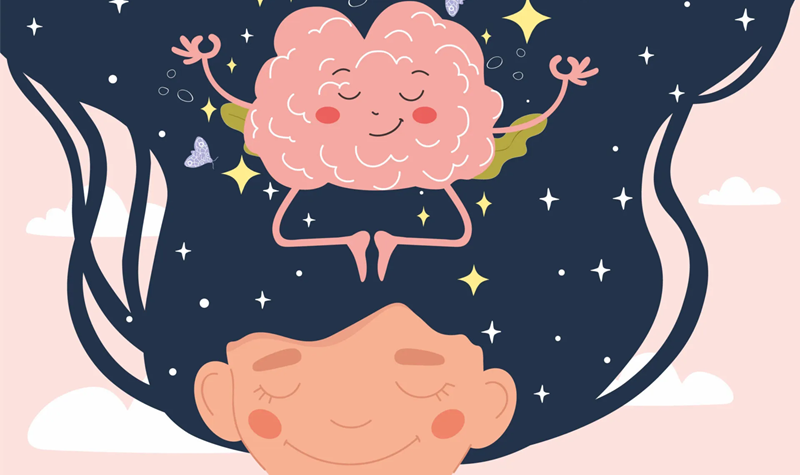The human mind is a complex, ever-evolving entity, constantly in a state of flux and motion. It is not uncommon for it to become restless, often filled with a whirlwind of thoughts and emotions that can create a sense of unease or discomfort.
Soothing a restless mind can involve a variety of strategies that are uniquely catered to the individual’s needs. Meditation, for example, is a practice that has been used for thousands of years to calm the mind, bringing a sense of tranquility and peace to its practitioner. It involves focusing one’s attention and eliminating the stream of jumbled thoughts that may be crowding the mind.
Exercise is another way to alleviate restlessness. Physical activity releases chemicals in the brain that act as natural mood lifters, potentially reducing feelings of anxiety and fostering a sense of well-being. Moreover, the rhythmic nature of certain types of exercise, such as running or swimming, can induce a state of meditation, further calming the mind. Various forms of creative expression, such as painting, writing, or playing a musical instrument, can also provide an outlet for the mind to focus and find peace.
In addition, connecting with nature can have a soothing effect on the restless mind. Research has shown that spending time in green spaces can reduce stress, increase relaxation, and boost mood. Whether it’s a stroll in the park, a hike in the woods, or simply sitting in a garden, being in nature can provide a sense of calm and contentment.
Sometimes, the mind’s restlessness can stem from unresolved issues or suppressed emotions. In such cases, seeking professional help, like a psychologist or a counselor, can be beneficial. These professionals are trained to help individuals navigate their thoughts and feelings, providing tools and techniques to manage and soothe the restless mind.
Nutrition is another area that can play a pivotal role in the state of our minds. Certain foods are known to promote brain health and mental well-being. For instance, foods rich in omega-3 fatty acids, such as fish and walnuts, can support brain function and mood regulation. Similarly, consuming a diet rich in fruits, vegetables, lean proteins, and whole grains can provide the nutrients necessary for optimal brain health.
Sleep is crucial too. A lack of quality sleep can exacerbate feelings of restlessness and anxiety. Establishing a regular sleep schedule, creating a restful environment, and avoiding stimulating activities before bedtime can help promote better sleep, leading to a calmer mind.
However, it’s important to remember that everyone is different, and what works for one person might not work for another. Finding the right combination of strategies to soothe a restless mind can take time and patience. It’s about creating a balance, embracing self-care, and understanding that it’s okay to seek help when needed. A calm mind is not a destination, but a journey, and each step towards it is a step towards greater mental well-being.

Understanding the Monkey Mind: What It Is and How It Affects You
The «Monkey Mind» is a concept that originates from Buddhism, referring to a state of mind that is restless, unsettled, confused, or constantly in flux, much like a monkey energetically jumping from one branch to another. It’s the mental chatter that fills your mind with anxieties, fears, and doubts, often leading to overthinking and stress. This ceaseless mental activity can have a profound impact on your mental health, well-being, and overall quality of life. Understanding the Monkey Mind is the first step towards regaining control over it and achieving a sense of inner peace.
This state of mind, unfortunately, is not uncommon in our modern, fast-paced society where we are continuously bombarded with information, responsibilities, and stimuli. We often find ourselves caught up in the whirlwind of our thoughts, jumping from one thought to another, without any respite. This constant mental noise not only disrupts our focus and productivity but also amplifies feelings of anxiety and dissatisfaction. It hinders us from living in the present moment and experiencing life to the fullest.
However, once we recognize and comprehend the workings of the Monkey Mind, we can employ various strategies to tame it. These strategies can include practices such as meditation, mindfulness, and yoga, which help in calming the mind, focusing the thoughts, and reducing anxiety.
They teach us to observe our thoughts without judgement, allowing us to distance ourselves from the constant chatter of our minds. In essence, understanding and managing the Monkey Mind is not about silencing it completely, but rather about learning to coexist with it peacefully. By doing so, we can significantly improve our mental health, boost our productivity, and enhance our overall well-being, leading to a more balanced and fulfilling life.
Effective Techniques for Quieting a Busy Mind
Effectual techniques for calming a bustling mind are essential for maintaining mental health and overall well-being. A busy mind can often feel overwhelming, leading to a myriad of issues like anxiety, stress, or even insomnia. However, there are several proven strategies to help alleviate these problems.
One of the most effective techniques is practicing mindfulness meditation, a method that requires focusing on the present moment and accepting it without judgment. This technique can be achieved through various methods such as yoga, tai chi, or simple breathing exercises. Another successful technique is physical activity.
Engaging in regular exercise can significantly reduce feelings of anxiety and improve one’s mood by boosting the production of endorphins, known as the body’s ‘feel-good’ hormones. It’s also critical to maintain a healthy sleep routine since lack of adequate rest can contribute to a busy mind. Techniques such as creating a restful environment, sticking to a sleep schedule, and avoiding caffeine or heavy meals before bedtime can help promote better sleep.
Additionally, taking time to engage in relaxing activities like reading a book, listening to calming music, or taking a warm bath can also help calm the mind. Finally, it’s crucial to maintain a balanced diet. Consuming foods rich in omega-3 fatty acids, antioxidants, and vitamins can help support brain function and promote mental calmness. These techniques, when practiced regularly and combined, can significantly help quiet a busy mind and improve overall mental health.

Mindfulness Practices to Achieve Mental Calmness
Mindfulness practices are effective strategies to achieve mental calmness and tranquility. Essentially, these practices involve focusing on the present moment, accepting it without judgement, and acknowledging one’s feelings, thoughts, and sensations. There are several techniques that can be used to promote mindfulness, each with their own unique benefits and approaches.
Meditation, for instance, is one of the most common mindfulness practices. It involves dedicating a specific amount of time to sit in silence, focus on one’s breath, and gently push away any distracting thoughts that may arise. The goal is not to block out all thoughts, but rather to acknowledge them without allowing them to consume one’s mind. This can lead to a state of inner peace and calmness.
Another popular mindfulness practice is yoga. Yoga combines physical postures with deep breathing and meditation to promote a sense of unity between the mind, body, and spirit. By focusing on maintaining the poses and coordinating one’s breath, yoga provides a highly effective way to stay present and mindful.
Mindful eating is yet another practice that can help achieve mental calmness. This involves paying full attention to the experience of eating, from the texture and taste of the food, to the act of chewing and swallowing. By slowing down and savoring each bite, one can fully appreciate the meal while also reducing stress and anxiety.
Lastly, daily mindfulness exercises such as taking a mindful walk or practicing mindful breathing can also be beneficial. These exercises involve focusing on one’s surroundings or breath, and bringing one’s attention back to the present whenever it starts to wander.
Regardless of the specific practice, the key to mindfulness is consistency. It may take time to get used to these exercises, but with regular practice, one can achieve a state of mental calmness, lower levels of stress, and an overall improved sense of well-being.
The Role of Meditation in Soothing Mental Restlessness
Meditation is a potent tool for calming mental restlessness, a state characterized by incessant worry, anxiety, and a racing mind. The practice of meditation, which has been utilized for thousands of years across various cultures, provides an individual with the opportunity to quiet these distractions and focus on the present moment. It allows them to gain mastery over their thoughts, emotions, and reactions, thereby fostering a sense of inner peace and tranquility.
The role of meditation in soothing mental restlessness lies in its ability to reorient our minds and shift our attention away from the whirlwind of thoughts that often leads to anxiety and stress. During meditation, one is encouraged to concentrate on their breath, a mantra, or a specific object, helping to narrow the focus and reduce the mental clutter. This focused attention helps to calm the mind and reduce the feelings of restlessness.
Furthermore, research has shown that regular practice of meditation can lead to changes in the brain’s structure and function, specifically in areas associated with stress regulation and attention control. These changes may contribute to an increased ability to manage stress and anxiety, leading to a more serene mental state.
In addition, mindfulness meditation, a specific form of meditation that involves non-judgmentally observing thoughts, feelings, and sensations as they arise, can be particularly effective in calming mental restlessness. By training the mind to observe without reaction or attachment, mindfulness meditation can help individuals recognize and disengage from patterns of rumination and worry, thereby promoting a sense of calm and clarity.
Ultimately, the role of meditation in soothing mental restlessness is about providing a space for the mind to rest, recover, and cultivate resilience. It is a practice that helps us to navigate the ebbs and flows of life with greater equanimity, fostering a state of mental calm and clarity amid the chaos.

Building Daily Habits to Maintain a Peaceful Mindset
Cultivating daily habits to sustain a peaceful mindset is a transformative approach to enhancing one’s overall well-being. This practice involves fostering a lifestyle that encourages mental tranquility and serenity. Daily meditation, for instance, is one such habit that can significantly contribute to a peaceful mindset.
The process of quieting one’s thoughts and focusing on the breath helps to ease stress and promotes a sense of calm. Another habit is the consistent practice of gratitude. Keeping a gratitude journal and recording one’s blessings can shift the focus from negative to positive, promoting an overall sense of contentment. Physical exercise is also crucial for mental peace.
It releases endorphins, the body’s natural mood enhancers, which can reduce anxiety and depression. Additionally, maintaining a balanced diet, rich in nutrients and vitamins that support brain health, can also significantly impact one’s mental state. The practice of mindfulness is yet another daily habit that can greatly contribute to a peaceful mind.
Paying attention to the present moment without judgment can help one to accept their feelings and thoughts without becoming overwhelmed. Lastly, regular sleep habits are essential for maintaining a peaceful mindset. Adequate rest can rejuvenate the mind, ensuring that one is better equipped to handle the stresses of daily life.
These are just a few examples of daily habits that, when incorporated into one’s routine, can help maintain a peaceful mindset. It’s important to remember that everyone is unique, and what works for one person may not work for another. Therefore, it’s crucial to explore different approaches and find the methods that best suit individual needs and personal circumstances.
